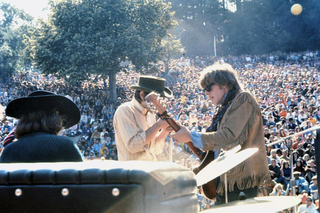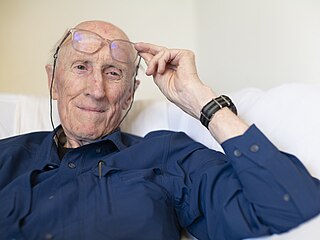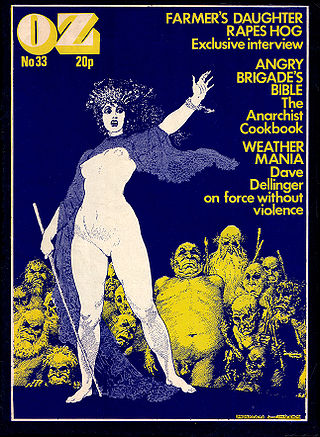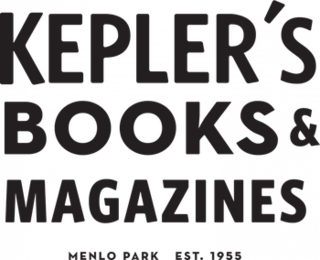Related Research Articles

The Summer of Love was a social phenomenon that occurred during the summer of 1967, when as many as 100,000 people, mostly young people sporting hippie fashions of dress and behavior, converged in San Francisco's neighborhood of Haight-Ashbury. More broadly, the Summer of Love encompassed the culture of hippie music, hallucinogenic drugs, anti-war sentiment, and free-love throughout the West Coast of the United States, and as far away as New York City.

A hippie, also spelled hippy, especially in British English, is someone associated with the counterculture of the 1960s, originally a youth movement that began in the United States during or around 1964 and spread to different countries around the world. The word hippie came from hipster and was used to describe beatniks who moved into New York City's Greenwich Village, San Francisco's Haight-Ashbury district, and Chicago's Old Town community. The term hippie was used in print by San Francisco writer Michael Fallon, helping popularize use of the term in the media, although the tag was seen elsewhere earlier.

A counterculture is a culture whose values and norms of behavior differ substantially from those of mainstream society, sometimes diametrically opposed to mainstream cultural mores. A countercultural movement expresses the ethos and aspirations of a specific population during a well-defined era. When oppositional forces reach critical mass, countercultures can trigger dramatic cultural changes. Prominent examples of countercultures in the Western world include the Levellers (1645–1650), Bohemianism (1850–1910), the more fragmentary counterculture of the Beat Generation (1944–1964), and the globalized counterculture of the 1960s (1965–1973). Countercultures differ from subcultures.

Stewart Brand is an American project developer and writer, best known as the co-founder and editor of the Whole Earth Catalog. He has founded a number of organizations, including the WELL, the Global Business Network, and the Long Now Foundation. He is the author of several books, most recently Whole Earth Discipline: An Ecopragmatist Manifesto.

Japantown, also known historically as Japanese Town, is a neighborhood in the Western Addition district of San Francisco, California. Japantown comprises about six city blocks and is considered one of the largest and oldest ethnic enclaves in the United States.

The terms underground press or clandestine press refer to periodicals and publications that are produced without official approval, illegally or against the wishes of a dominant group. In specific recent Asian, American and Western European context, the term "underground press" has most frequently been employed to refer to the independently published and distributed underground papers associated with the counterculture of the late 1960s and early 1970s in India and Bangladesh in Asia, in the United States and Canada in North America, and the United Kingdom and other western nations. It can also refer to the newspapers produced independently in repressive regimes. In German occupied Europe, for example, a thriving underground press operated, usually in association with the Resistance. Other notable examples include the samizdat and bibuła, which operated in the Soviet Union and Poland respectively, during the Cold War.

"The Mother of All Demos" was a landmark computer demonstration of developments by the Augmentation Research Center, given at the Association for Computing Machinery / Institute of Electrical and Electronics Engineers (ACM/IEEE)—Computer Society's Fall Joint Computer Conference in San Francisco, by Douglas Engelbart, on December 9, 1968. The name The Mother of All Demos has been retroactively applied to the demonstration.

The Whole Earth 'Lectronic Link, normally shortened to The WELL or, alternatively, The Well, is a virtual community that was launched in 1985. It is one of the oldest continuously operating virtual communities. By 1993 it had 7,000 members, a staff of 12, and gross annual income of $2 million. A 1997 feature in Wired magazine called it "The world's most influential online community." In 2012, when it was last publicly offered for sale, it had 2,693 members. It is best known for its Internet forums, but also provides email, shell accounts, and web pages. Discussion topics are organized into conferences that cover broad areas of interest. User anonymity is prohibited.

Lee Felsenstein is an American computer engineer who played a central role in the development of personal computers. He was one of the original members of the Homebrew Computer Club and the designer of the Osborne 1, the first mass-produced portable computer.

John Burdette Gage is a retired computer scientist and technology executive. He was the 21st employee of Sun Microsystems, where he is credited with creating the phrase The Network is the Computer. He served as Sun's vice president and chief researcher and director of the Science Office, until leaving on June 9, 2008, to join Kleiner Perkins Caufield & Byers as a partner to work on green technologies for global warming; he departed KPCB in 2010 to apply what he had learned "to broader issues in other parts of the world".

Kepler's Books and Magazines is an independent bookstore in Menlo Park, California. It was founded on May 14, 1955 by Roy Kepler. He previously had worked as a staff member of radio station KPFA, listener-supported and based in Berkeley. The bookstore "soon blossomed into a cultural epicenter and attracted loyal customers from the students and faculty of Stanford University and from other members of the surrounding communities who were interested in serious books and ideas."

Community Memory (CM) was the first public computerized bulletin board system. Established in 1973 in Berkeley, California, it used an SDS 940 timesharing system in San Francisco connected via a 110 baud link to a teleprinter at a record store in Berkeley to let users enter and retrieve messages. Individuals could place messages in the computer and then look through the memory for a specific notice.

The counterculture of the 1960s was an anti-establishment cultural phenomenon and political movement that developed in the Western world during the mid-20th century. It began in the early 1960s, and continued through the early 1970s. It is often synonymous with cultural liberalism and with the various social changes of the decade. The effects of the movement have been ongoing to the present day. The aggregate movement gained momentum as the civil rights movement in the United States had made significant progress, such as the Voting Rights Act of 1965, and with the intensification of the Vietnam War that same year, it became revolutionary to some. As the movement progressed, widespread social tensions also developed concerning other issues, and tended to flow along generational lines regarding respect for the individual, human sexuality, women's rights, traditional modes of authority, rights of people of color, end of racial segregation, experimentation with psychoactive drugs, and differing interpretations of the American Dream. Many key movements related to these issues were born or advanced within the counterculture of the 1960s.
The hippie subculture began its development as a youth movement in the United States during the early 1960s and then developed around the world.
During the "hippie" period 1967–1968 in San Francisco, an individual named Al Rinker started an organization located at 1830 Fell St in the city's Haight Ashbury district called the Switchboard. Its purpose was to act as a social switchboard for people living there.

The Pennywhistle was an early acoustic coupler modem originally designed and built by Lee Felsenstein in 1973, and later commercialized and offered for sale in 1976. It was one of the earliest modems available for hobbyist computer users. Like most acoustic coupler modems, the Pennywhistle was replaced by the Hayes Smartmodem and similar models from the early 1980s.
Arthur Scott Evans was an early gay rights advocate and author, best known for his 1978 book Witchcraft and the Gay Counterculture. Politically active in New York City in the 1960s and early 1970s, he and his partner began a homestead in Washington state in 1972, then later moved to San Francisco where he became a fixture in the Haight-Ashbury neighborhood. In his later years, Evans remained politically active and continued as a translator and academic. His 1997 book Critique of Patriarchal Reason argued that misogyny had influenced "objective" fields such as logic and physics.
Pamela Hardt-English is an American food scientist and computer scientist who created Resource One, a "people's computing center" in 1972 at Project One, a "technological commune" in San Francisco, California.
Tanya Marie Neiman was an American lawyer and activist based in San Francisco. For over 20 years, she was director of the Volunteer Legal Services Program of the Bar Association of San Francisco, now known as the Justice & Diversity Center, "one of the largest and most innovative legal services programs in the country to serve lower-income people".
References
- 1 2 "Pueblo in the City-Plumbers, computer freaks, architects and visionaries turn a vacant San Francisco candy factory into a technological commune". Mother Jones. May 1976.
- ↑ Mosher, Craig R. (1973). "ONE: An Urban Community". The Journal of Applied Behavioral Science. The Journal of Applied Behavioral Science - NTL Institute. 9 (2–3): 218–232. doi:10.1177/002188637300900208. S2CID 144184730.
- ↑ Dittmer, John (31 January 2017). The Good Doctors: The Medical Committee for Human Rights and the Struggle for Social Justice in Health Care. Univ. Press of Mississippi. ISBN 9781496810380.
- ↑ "Timeline | Ecology Center". 3 March 2010.
- ↑ "Eric Dollard". Borderland Sciences Research Catalog.
- ↑ "Joel Fort, psychiatrist who campaigned against orthodoxy, dies". 29 August 2015.
- ↑ "Albert Neiman Obituary (2020) San Francisco Chronicle". Legacy.com .
- ↑ "Project One (San Francisco) Documentary by Optic Nerve". 1972. Retrieved 24 May 2018– via archive.org.
- ↑ "Community Memory: 1972 - 1974, Berkeley and San Francisco, California". The WELL: Whole Earth 'Lectronic Link.
- ↑ Stewart Brand (December 7, 1972). "Spacewar: Fanatic Life and Symbolic Death Among the Computer Bums". Rolling Stone . Retrieved April 16, 2011.
- ↑ Markoff, John (2014). What the Dormouse Said: How the Sixties Counterculture Shaped the Personal Computer Industry. New York: Penguin Books. p. 238. ISBN 9781101201084. OCLC 883344790.
- ↑ Doub, Bo (23 February 2016). "Community Memory: Precedents in Social Media and Movements". Computer History Museum. Retrieved 13 August 2017.
- ↑ "1973 the Community Memory Project". 22 March 2015.
- ↑ https://sonomabiocharinitiative.org/wp-content/uploads/2019/06/How-I-Got-Hooked-on-Biochar-1.pdf [ bare URL PDF ]
- ↑ The Turning: A History of Vietnam Veterans Against the War. NYU Press. May 2001. ISBN 9780814736357.
- ↑ "S..F Vietnam War vet Lee Thorn, peace activist who aided Laos, dead at 77". 2 July 2020.
- ↑ "Veterans' activist dies at 53". 18 February 1996.